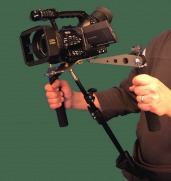 You’ve got the camera. Now what? When filmmakers come to the Canon Boot Camp, one of the sections they look forward to is the gear demo. Thanks to our sponsors such as RedRock, Manfrotto and Alzo! Because of the size and dynamics of the camera, it can be used in so many ways and situations. Its size can be an advantage and a pitfall; but the right rig can enhance the camera. Also, because of its versatility, there are so many different types of rigs manufactured for the Canon HDSLRs and finding the right one for your specific type of work can be a challenge, yet it is so important.
You’ve got the camera. Now what? When filmmakers come to the Canon Boot Camp, one of the sections they look forward to is the gear demo. Thanks to our sponsors such as RedRock, Manfrotto and Alzo! Because of the size and dynamics of the camera, it can be used in so many ways and situations. Its size can be an advantage and a pitfall; but the right rig can enhance the camera. Also, because of its versatility, there are so many different types of rigs manufactured for the Canon HDSLRs and finding the right one for your specific type of work can be a challenge, yet it is so important.
I am a shooter that likes to operate mostly hand-held and as bare bones as possible. If I am moving around, I sometimes use a monopod for stability, but if I am stationary most of the time, the tripod is my best friend. If there is a rig that I recommend, it is the DVTec multirig, which I’ve written about previously, and will expand on below. So, this post reflects my personal experiences using rigs and helping people find the right rig for their specific style and type of shooting.
Meet “The Guinness Rig” from Fletch Murray/CineBootCamp on Vimeo.
A lot of HDSLR users go right for shoulder rigs. Maybe it’s because they’ve seen how cool Shane Hurlbut looks with one, or maybe it’s because they see the rigs being sold everywhere, so they must be a necessity. Such is not the case. I am personally not a fan of shoulder rigs because I feel that they restrict my motion while I am filming.
Also, the more accessories piled onto the rig along with the camera, such as a mic, a monitor, follow focus, etc, the heavier it gets on one side of your body. This makes it difficult to use it one-handed so focusing, zooming, etc can become more challenging. Shoulder rigs would be good if your shots are mainly shoulder level, like for a newscast, but I’ve found that my mobility is restricted if I’m trying to shoot lower than that, unless I put myself in some uncomfortable squats.
Recently, I was talking to a skateboarder who films skate events and he told me he was interested in using a steadicam while skating. I suggested trying the DVTec Multirig for more stability which sounded great to him until I mentioned that the great thing about it is the rod that comes down to the waist. All filmmakers I’ve told about this rig understand right away that the rod is ingenious. However, this time the response was completely different. He knew right away that it wouldn’t work. Why? Because if he fell off his board, the rod would be the death of him, plunging through his stomach while he went down hill at 35 miles an hour.
That’s when it really hit me how important rigs are to the specific type of filming one does. Not only could the wrong rig hinder you from capturing your shot, but it could also cause you some bodily harm. Seems like his original idea of using a steadicam might be his best bet. A big hit amongst skaters is the Scorpion by CamCaddie, or rigs like it. It can be operated with one hand and it is very lightweight.
There are so many different styles of rigs and gear you can use. Research and trial is key to getting the right equipment. Another accessory that people ask about a lot is follow focus. A follow focus ring and the actual gear can be cumbersome at times and inconvenient to use if you are on the wrong rig and operating as a one-man band. Again, personally, I like to be as light as possible. The rig I do recommend is the DVTec Multirig, which I mentioned above. It provides mobility, flexibility, and takes the weight off the shoulders.
A new rig soon to be out on the market that blows my mind is the movi rig by Firefly. It operates on an axis and a gimbal that provides supreme stability to the camera. You can shift the camera up and down, left and right, run with it, skate with it, operate it with one hand or two and your camera will always be level. Wanna see it in action? Check out this video:
Passion for Motion – Behind the Scenes from Freefly on Vimeo.
I’ve contacted the manufacturer about sending a demo for the Canon Boot Camp, but unfortunately they are unable to do that at the moment. I can’t wait to get my hands on one, but at approximately 15,000 dollars right now, I can just keep dreaming about it.
This was just a brief overview of rigs to emphasize the many different types of equipment that is available to us so that we can master our HDSLRs. Not all rigs are made equal and not all rigs will solve all problems, so shop carefully!
- See more at: http://blog.theassociation.tv/blog/the-association/page/2#sthash.mP5wCmNy.dpuf
